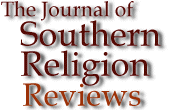

Abrams, Douglas Carl. Selling the Old-Time Religion: American Fundamentalists and Mass Culture, 1920-1940. Athens: The University of Georgia Press, 2001. 168 pp.
In this recent book, Carl Abrams shows how fundamentalists between World War I and World War II negotiated the many challenges and seductions of American mass culture. Abrams does an excellent job synthesizing the best scholarship and primary source material to emphasize how fundamentalists in this twenty-year period spread their faith through radio, television, magazines, and periodicals. His thesis, that fundamentalists both incorporated and rejected elements of modern culture in the inter-war years, is not a new assertion, but it does challenge the assumption that fundamentalists and evangelicals were and continue to be, a homogeneous group. Fundamentalists are as complex as the society in which they live and in which they advertise their values. Abrams does a commendable job showing fundamentalists’ paradox; as antimodernists, they eschewed modern culture as they embraced certain elements for their evangelization, and they used, and continue to use, mass culture not to be like the world, but to evangelize it (xii).
|
|
|
| "The strengths of this book lie in the synthesis of information on fundamentalist culture and in the multitude of details that Abrams uses." | |
In his four main chapters, "Embracing Consumer Society," "Reflecting Consumer Society," Encountering Popular Culture," and "Judging Popular Culture," Abrams shows how the fundamentalist paradox carried over into the multiple layers of fundamentalist culture, including the home and family; colleges and universities; business and work; and popular culture. Fundamentalists’ views were in step with Victorian values and biases; they were anti-urban, anti-immigrant, anti-rum, and anti-Catholic, as were most Americans in the inter-war years. Fundamentalists also mirrored larger American society’s ambiguity about women and their role in public life. While women’s roles in the home were valued and encouraged in the Victorian ethos, women’s participation in the work place, even when it was an economic necessity for their families, was not embraced. Fundamentalists supported the Victorian ideal of motherhood and stay-at-home mothers.
Abrams discusses fundamentalist ambiguities about secular culture, and how distinctions were made between "low" and "high" culture. While billiards, playing cards, and movie-going may have been unacceptable for fundamentalists, the theater and the arts were actively promoted at Bob Jones University in the thirties and forties. Abrams portrays the lively debate between Wheaton College’s President James O. Buswell and Bob Jones Sr. and Jr. over the redeeming qualities of Shakespeare, for example, as a window into the inter-fundamentalist debates of the time. While Buswell decried the incorporation of so-called high culture in fundamentalist college curricula, the Joneses believed that plays and theater not only complemented Christianity, but elevated it to a higher level (82).
This book is a solid contribution to the growing body of scholarship on fundamentalism and would be a good choice for upper-level religion courses or graduate-level courses on religion in the United States. It is clearly-written, well-documented and researched, and the author, a fundamentalist, portrays fundamentalist culture from a scholarly perspective. This book is not a fundamentalist apologetic; Abrams incorporates critical analysis throughout the book. The book is appropriate for general use as well, although terms such as premillennial and predestinarian are not defined and may not be familiar to the general reader. The strengths of this book lie in the synthesis of information on fundamentalist culture and in the multitude of details that Abrams uses. What Abrams argues about fundamentalists in the inter-war period provides an excellent backdrop for the study of contemporary fundamentalism.
Kristy Nabhan-Warren, Augustana College
© 2001 by The Journal
of Southern Religion. All rights reserved. ISSN 1094-5234